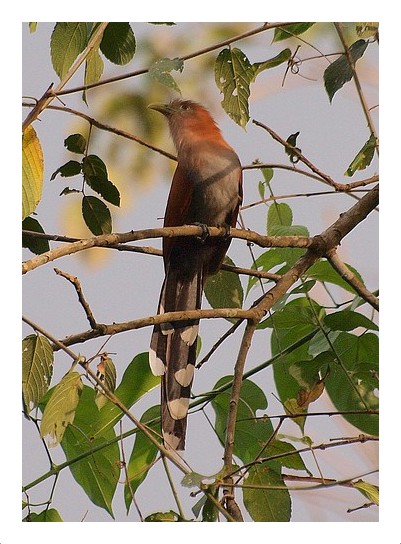Costa Rica Trip Report (August 2002)

Every year, my husband's family has a family reunion, courtesy of his very generous father. This year the chosen destination was Costa Rica. No, my father-in-law is not a birder — in fact, my son Patrick and I are the only birders in the entire extended family! Costa Rica appealed to my husband's family because some members, my husband included, are besotted about surfing (having grown up in Southern CA). But Patrick and I certainly didn't complain! The first thing we did was purchase a copy of The Birds of Costa Rica and began feverishly studying the templates. With over 800 species, it was a bit overwhelming to say the least.
We flew to San Jose on a Friday in mid-August and stayed overnight there. It was dark when we arrived, so we had no idea of what surrounded us. Saturday morning I woke early and went outside. Above the city roof-tops, I was greeted with the sight of lush green mountains. On the ground was a male Rufous-collared Sparrow and his mate. Swallows I couldn't identify in the early morning light dipped and soared over an empty lot nearby.
We took a bus from San Jose to the town of Tamarindo, which sits on the northern Pacific Coast, in the Guanacaste region. This trip of about 100 miles took several hours because the main road (the Interamericana) is a two-lane highway riddled with pot holes and frequented by slow-moving trucks in low gear. Add the mountains and, well, you get the picture. The highlight of our bus trip from a birding perspective was when a Squirrel Cuckoo (above) flew across the road. Unmistakable!
We stayed for a week at a wonderful Bed & Breakfast in Tamarindo called Villa Alegre. Technically, August is the rainy season in Guanacaste but it was abnormally dry while we were there. All around the house, the White-throated Magpie-Jays, unique to the region were in a constant uproar. These black, blue and white birds have a tail longer than their bodies, and an exotic long curled crest. Cinnamon, Magnificent (now Rivoli's) and Fork-tailed Emerald (also Cavinet's Emerald) Hummingbirds were frequent visitors to the tropical flowers on the property. Great Kiskadees feasted on the hundreds of dragonflies that hovered over the pool. Overhead the sky was never free of gliding Magnificent Frigatebirds, and we'd see an occasional White Ibis winging away. The short walk to the shore featured the Streaked-backed Oriole, White-lored Gnatcatcher, and Rufous-naped and Banded Wrens. Over the water were many Brown Pelicans, and shorebirds enjoyed the tide pools left in the crevices of the lava beach at low-tide. They were often hard for us to identify (shorebirds are not my strong point), but we saw Spotted Sandpipers, Wilson's Plovers and Ruddy Turnstones. I missed the company of you Three Rivers Birding Club experts more than once!
Strolls along the dirt roads in Tamarindo, and horseback rides into the dry tropical forest of nearby Parque San Fransisco brought us in close contact with howler monkeys and species of parrots, the Tropical Kingbird, Violaceous Trogons (also called Gartered Trogon), Groove-billed Anis, Turkey Vulture, Scrub Euphonias and other species. We especially enjoyed the antics of the Blue-black Grassquit, which flitted vertically upward for a foot or so and fluttered back down to the same perch (a fence at the edge of pasture) during song. He did these song-jumps every few seconds.
Our hosts, Suzye & Barry Lawson, made arrangements for us to go on a few guided tours of the region, with an emphasis on bird identification. One tour was to the Parque Palo Verde, where we traveled by boat along the Rio Tempesque. In addition to howler and white-faced capuchin monkeys, bats, crocodiles and iguanas, we saw several species of birds including Bananaquits, Kiskadees, Little Blue Herons, Cattle and Great Egrets, Wood Storks and Boat-billed Herons.
Another time, Patrick and I went kayaking through the surf at Playa Langosta into the Rio San Fransisco estuary. Mangrove Warblers came out at the sound of pishing, and all types of herons stalked in the roots of the mangroves (Boat-billed, Chestnut-bellied (Agami), Yellow-crowned Night-Heron, Green (formerly Green-backed). Amazon Kingfishers dove into the water, Limpkins and a Common Gallinule, perched on dead stumps. A flamingo flew overhead. We disembarked and hiked through the forest and saw howler monkeys, a Black-throated Trogon, and Lineated, Hoffmann's and Red-crowned Woodpeckers.
While I enjoyed our trip tremendously, I know what I will do differently when I return to fabulous Costa Rica. First of all, I will not stay in one place! Costa Rica has several distinct regions with birds to match. While it takes a long time to travel around the country because of the roads (unless you opt for a little puddle-hopping airplane), it is well worth the effort. Next trip, you'll find Patrick and me at the Monteverde Cloud Forest Reserve hoping for a glimpse of the Resplendent Quetzal and a toucan or two!
— by Joanne Scheier & Patrick Susoeff
See Patrick Susoeff's later report on "The Hunt for the Quetzal."





